Theoretical Analysis of the Catalytic Hydrolysis Mechanism of HCN over Cu-ZSM-5
Abstract
:1. Introduction
2. Computational Details
3. Results and Discussion
3.1. Path A
| Path A Cu-RC1 | 0.00 | 0.00 | 0.00 | 0.00 | 0.00 | 0.00 | |
| Cu-TS1 | 51.13 | −3.30 | 49.92 | 48.60 | 48.60 | 51.89 | 51.89 |
| Cu-INT1 | 0.00 | −4.29 | −9.83 | −11.34 | −11.34 | −7.05 | |
| Cu-TS2 | −11.74 | −5.75 | −8.03 | −10.04 | −1n0.04 | −4.29 | 2.76 |
| Cu-INT2 | −11.74 | −5.74 | −8.03 | −10.04 | −10.04 | −4.30 | |
| Cu-TS3 | −11.74 | −5.75 | −8.03 | −10.04 | −10.04 | −4.29 | 0.01 |
| Cu-INT3 | 4.95 | −2.87 | 7.61 | 6.44 | 6.44 | 9.31 | |
| Cu-TS4 | 31.31 | −3.04 | 30.87 | 29.59 | 29.59 | 32.63 | 23.32 |
| Cu-INT4 | −19.27 | −2.91 | −16.22 | −17.34 | −17.35 | −14.44 | |
| Cu-TS5 | 73.62 | −2.06 | 71.55 | 70.65 | 70.65 | 72.72 | 87.15 |
| Cu-PC1 | −11.17 | 1.24 | −10.37 | −10.14 | −10.14 | −11.38 |
3.2. Path B
| Path B Cu-RC1 | 0.00 | 0.00 | 0.00 | 0.00 | 0.00 | 0.00 | |
| Cu-TS1 | 51.13 | −3.30 | 49.92 | 48.60 | 48.60 | 51.89 | 51.89 |
| Cu-INT1 | −12.96 | −4.06 | −9.34 | −10.76 | −10.76 | −6.70 | |
| Cu-TS6 | 67.03 | −4.43 | 66.45 | 64.99 | 64.99 | 69.43 | 76.13 |
| Cu-INT5 | −10.03 | −3.79 | −6.55 | −8.46 | −8.46 | −4.67 | |
| Cu-TS7 | 21.75 | −3.48 | 22.98 | 21.47 | 21.47 | 24.95 | 29.62 |
| Cu-INT6 | −4.44 | −3.65 | −1.30 | −2.72 | −2.72 | 0.93 | |
| Cu-TS8 | 33.56 | −5.72 | 33.38 | 31.33 | 31.33 | 37.04 | 36.11 |
| Cu-PC2 | −32.97 | −3.59 | −31.28 | −32.75 | −32.75 | −29.16 |
3.3. Path C
| Path C Cu-HCN | 0.00 | 0.00 | 0.00 | 0.00 | 0.00 | 0.00 | |
| Cu-TS9 | 30.72 | 1.21 | 27.81 | 28.06 | 28.06 | 26.86 | 26.86 |
| Cu-HNC | 15.36 | −3.46 | 14.20 | 14.54 | 14.54 | 18.00 | |
| Cu-RC2 | 0.00 | 0.00 | 0.00 | 0.00 | 0.00 | 0.00 | |
| Cu-TS10 | 19.47 | −3.05 | 19.76 | 18.25 | 18.25 | 21.31 | 21.31 |
| Cu-INT7 | −33.87 | −2.30 | −29.35 | −30.69 | −30.69 | −28.39 | |
| Cu-TS11 | 0.09 | −1.16 | 1.95 | 0.67 | 0.67 | 1.83 | 30.22 |
| Cu-INT8 | −24.86 | −0.52 | −21.34 | −22.33 | −22.33 | −21.82 | |
| Cu-TS12 | 12.15 | −2.31 | 12.65 | 11.32 | 11.32 | 13.63 | 35.45 |
3.4. Path D
| Cu-RC3 | 0.00 6 | 0.00 | 0.00 | 0.00 | 0.00 | 0.00 | |
| Cu-INT9 | 11.62 | 0.44 | 11.20 | 11.33 | 11.33 | 10.90 | |
| Cu-TS13 | 15.49 | 0.58 | 15.11 | 15.01 | 15.01 | 14.43 | 14.43 |
| Cu-INT10 | −1.54 | 0.65 | −0.64 | −0.58 | −0.58 | −1.23 | |
| Cu-TS14 | 10.74 | −0.53 | 8.41 | 8.11 | 8.11 | 8.64 | 9.88 |
| Cu-INT11 | 10.53 | 1.52 | 9.55 | 9.84 | 9.84 | 8.32 | |
| Cu-INT12 | 0.00 | 0.00 | 0.00 | 0.00 | 0.00 | 0.00 | |
| Cu-TS15 | 50.76 | −6.63 | 50.28 | 48.66 | 48.66 | 55.29 | 55.29 |
| Cu-INT13 | −4.94 | −6.89 | −0.81 | −2.50 | −2.50 | 4.39 | |
| Cu-TS16 | 27.10 | −6.85 | 28.84 | 27.07 | 27.07 | 33.92 | 29.53 |
| Cu-INT14 | 0.90 | −6.77 | 4.56 | 2.90 | 2.90 | 9.67 | |
| Cu-TS17 | 39.87 | −7.98 | 39.69 | 37.58 | 37.58 | 45.57 | 35.90 |
| Cu-PC4 | −28.50 | −5.95 | −26.07 | −27.04 | −27.04 | −21.09 |
3.5. Path E
| Path E Cu-RC3 | 0.00 | 0.00 | 0.00 | 0.00 | 0.00 | 0.00 | |
| Cu-INT9 | 11.62 | 0.44 | 11.20 | 11.33 | 11.33 | 10.90 | |
| Cu-TS13 | 15.49 | 0.58 | 15.11 | 15.01 | 15.01 | 14.43 | 14.43 |
| Cu-INT10 | −1.54 | 0.65 | −0.64 | −0.58 | −0.58 | −1.23 | |
| Cu-INT15 | 0.00 | 0.00 | 0.00 | 0.00 | 0.00 | 0.00 | |
| Cu-TS18 | 68.90 | 0.16 | 54.59 | 54.41 | 54.41 | 54.25 | 54.25 |
| Cu-INT16 | −4.46 | −0.54 | −1.97 | −2.66 | −2.66 | −2.12 | |
| Cu-TS19 | 35.09 | −0.59 | 33.88 | 33.21 | 33.21 | 33.80 | 35.92 |
| Cu-PC5 | −33.27 | 1.21 | −32.11 | −31.99 | −31.99 | −33.20 |
4. Conclusions
Author Contributions
Funding
Data Availability Statement
Acknowledgments
Conflicts of Interest
References
- Wang, Z.; Jiang, M.; Ning, P.; Xie, G. Thermodynamic modeling and gaseous pollutionprediction of the yellow phosphorus production. Ind. Eng. Chem. Res. 2011, 50, 12194–12202. [Google Scholar] [CrossRef]
- Zhao, Q.; Tian, S.; Yan, L.; Zhang, Q.; Ning, P. Novel HCN sorbents based on layered double hydroxides: Sorption mechanism and performance. J. Hazard. Mater. 2015, 285, 250–258. [Google Scholar] [CrossRef] [PubMed]
- Sing, K.S.W. Reporting physisorption data for gas/Solid systems-with Special Reference to the Determination of Surface Area and Porosity. Pure Appl. Chem. 1985, 57, 603–619. [Google Scholar] [CrossRef]
- Yang, Y.; Suh, S. Environmental impacts of products in China. Environ. Sci. Technol. 2011, 45, 4102–4109. [Google Scholar] [CrossRef] [PubMed]
- Jiang, M.; Wang, Z.H.; Ning, P.; Tian, S.L.; Huang, X.F.; Bai, Y.W.; Shi, Y.; Ren, X.G.; Chen, W.; Qin, Y.S.; et al. Dust removal and purificationofcalcium carbide furnace off-gas. Environ. Sci. Technol. 2014, 45, 901–907. [Google Scholar]
- Ma, J.; Dasgupta, P.K. Recent developments in cyanide detection: A review. Anal. Chim. Acta 2010, 673, 117–125. [Google Scholar] [CrossRef] [Green Version]
- Tang, Y.; Chen, W.; Li, C.; Pan, L.; Dai, X.; Ma, D. Adsorption behavior of Co anchored on graphene sheets toward NO, SO2, NH3, CO and HCN molecules. Appl. Surf. Sci. 2015, 342, 191–199. [Google Scholar] [CrossRef]
- Liu, J.H.; Lv, C.Q.; Guo, Y.; Wang, G.C. Theoretical study of the adsorption and dissociation mechanism for methylamine on Pd(111). Appl. Surf. Sci. 2013, 271, 291–298. [Google Scholar] [CrossRef]
- Hu, Y.; Liu, J.; Cheng, J.; Wang, L.; Tao, L.; Wang, Q.; Wang, X.; Ning, P. Coupling catalytic hydrolysissand oxidation of HCN over HZSM-5 modified by metal (Fe, Cu) oxides. Appl. Surf. Sci. 2018, 427, 843–850. [Google Scholar] [CrossRef]
- Kröcher, O.; Elsener, M. Hydrolysissand oxidation of gaseous HCN over heterogeneous catalysts. Appl. Catal. B 2009, 92, 85–89. [Google Scholar] [CrossRef]
- Wang, L.; Wang, X.; Jing, X.; Ning, P. Efficient removal of HCN through catalytic hydrolysissand oxidation on Cu/CoSPc/Ce metal-modified activated carbon under low oxygen conditions. RSC Adv. 2016, 6, 113834–113843. [Google Scholar] [CrossRef]
- Giménez-López, J.; Millera, A.; Bilbao, R.; Alzueta, M.U. HCN oxidation in an O2/CO2, atmosphere: An experimental and kinetic modeling study. Combust. Flame 2010, 157, 267–276. [Google Scholar] [CrossRef]
- Marsh, J.D.F.; Newling, W.B.S.; Rich, J. The catalytic hydrolysissof hydrogen cyanide to ammonia. J. Chem. Technol. Biotechnol. 2010, 2, 681–684. [Google Scholar]
- Nanba, T.; Obuchi, A.; Akaratiwa, S.; Liu, S.; Uchisawa, J.; Kushiyama, S. Catalytic hydrolysissof HCN over H-Ferrierite. Chem. Lett. 2000, 2000, 986–987. [Google Scholar] [CrossRef]
- Wang, L.; Wang, X.; Cheng, J.; Ning, P.; Lin, Y. Coupling catalytic hydrolysissand oxidation on Mn/TiO2-Al2O3 for HCN removal. Appl. Surf. Sci. 2018, 439, 213–221. [Google Scholar] [CrossRef]
- Jensen, J.O.; Krishnan, P.N.; Burke, L.A. Theoretical study of possible products of the combination of H2O and HCN. J. Mol. Struct. 1996, 370, 245–252. [Google Scholar] [CrossRef]
- Li, J.; Han, K.L.; He, G.Z. Computational study on the addition of HCN to methanimine catalyzed by formamidine and formamide. J. Mol. Struc. Theochem. 2005, 713, 51–57. [Google Scholar] [CrossRef] [Green Version]
- Koch, D.M.; Toubin, C.; Xu, S.; Peslherbe, G.H.; Hynes, J.T. Concerted proton-transfer mechanism and solvation effects in the HNC/HCN isomerization on the surface of icy grain mantles in the interstellar medium. J. Phys. Chem. C 2007, 111, 15026–15033. [Google Scholar] [CrossRef]
- Basharnavaz, H.; Habibi-Yangjeh, A.; Mousavi, M. Ni, Pd, and Pt-embedded graphitic carbon nitrides as excellent adsorbents for HCN removal: A DFT study. Appl. Surf. Sci. 2018, 456, 882–889. [Google Scholar] [CrossRef]
- Song, X.; Ning, P.; Li, K.; Sun, X.; Wang, C.; Sun, L. Hydrogen transfer effect and reaction mechanism for catalytic hydrolysiss of HCN in ionic liquids: A density functional theory study. Chem. Eng. J. 2018, 348, 630–636. [Google Scholar] [CrossRef]
- Kachurovskaya, N.A.; Zhidomirov, G.M.; Hensen, E.J.; van Santen, R.A. Cluster model DFT study of the intermediates of benzene to phenol oxidation by N2O on FeZSM-5 zeolites. Catal. Lett. 2003, 86, 25–31. [Google Scholar] [CrossRef]
- Zhang, B.; He, G.; Shan, Y.; He, H. Experimental and DFT study of the adsorption of N2O on transition ion-exchanged ZSM-5. Catal. Today 2019, 327, 177–181. [Google Scholar] [CrossRef]
- Li, G.; Pidko, E.A.; van Santen, R.A.; Feng, Z.; Li, C.; Hensen, E.J. Stability and reactivity of active sites for direct benzene oxidation to phenol in Fe/ZSM-5: A comprehensive periodic DFT study. J. Catal. 2011, 284, 194–206. [Google Scholar] [CrossRef]
- Czekaj, I.; Brandenberger, S.; Kröcher, O. Theoretical studies of HNCO adsorption at stabilized iron complexes in the ZSM-5 framework. Micropor. Mesopor. Mat. 2013, 169, 97–102. [Google Scholar] [CrossRef]
- Xia, F.; Ning, P.; Zhang, Q.; Li, F.; Tao, G.; Tian, K.; Huang, X.; Peng, J.; Zhu, H. A gas-phase ab initio study of the hydrolysiss of HCN. Theor. Chem. Acc. 2016, 135, 1–14. [Google Scholar] [CrossRef]
- Kuharski, R.A.; Rossky, P.J. A quantum-mechanical study of structure in liquid H2O and D2O. J. Chem. Phys. 1985, 82, 5164–5177. [Google Scholar] [CrossRef]
- Balucani, N.; Asvany, O.; Chang, A.H.H.; Lin, S.H.; Lee, Y.T.; Kaiser, R.I.; Osamura, Y. Crossed beam reaction of cyano radicals with hydrocarbon molecules. III. Chemical dynamics of vinylcyanide (CHCN;XA) formation from reaction of CN(X) with ethylene, CH(X1Ag). J. Chem. Phys. 2000, 113, 8643. [Google Scholar] [CrossRef]
- Baboul, A.G.; Curtiss, L.A.; Redfern, P.C.; Raghavachari, K. Gaussian-3 theory using density functional geometries and zero-point energies. J. Chem. Phys. 1999, 110, 7650–7657. [Google Scholar] [CrossRef]
- Gonzalez, C.; Schlegel, H.B. An improved algorithm for reaction path following. J. Chem. Phys. 1989, 90, 2154–2161. [Google Scholar] [CrossRef]
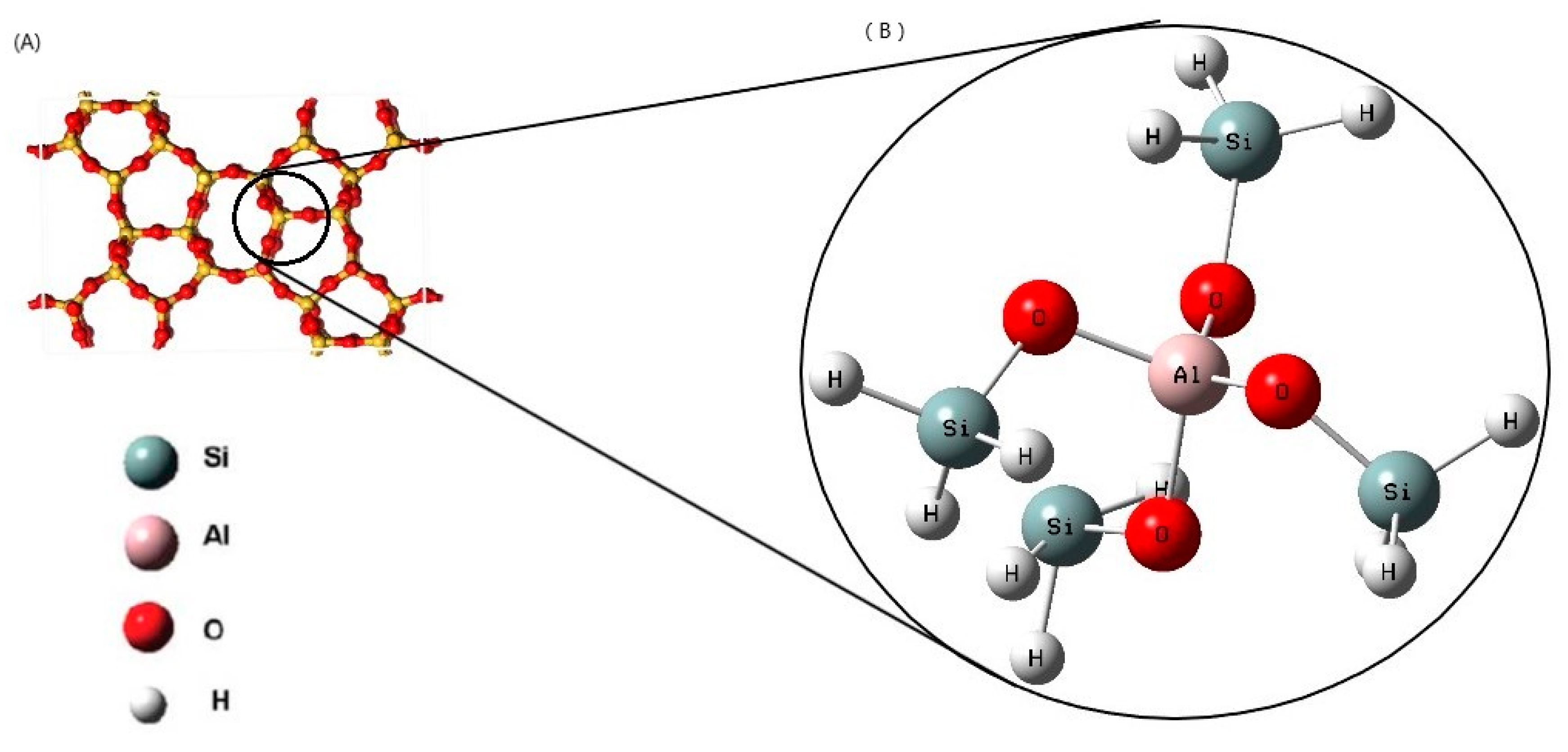

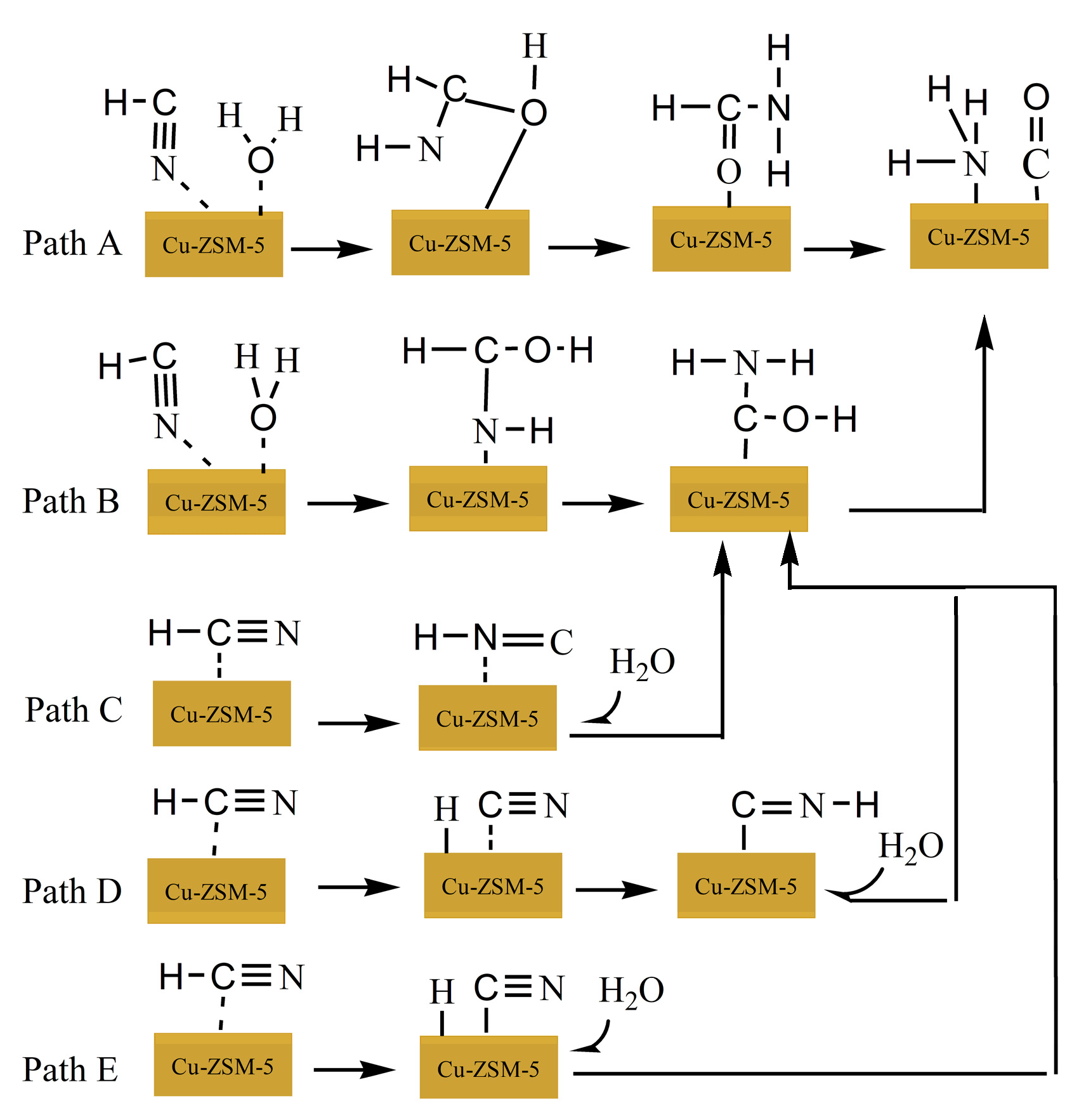

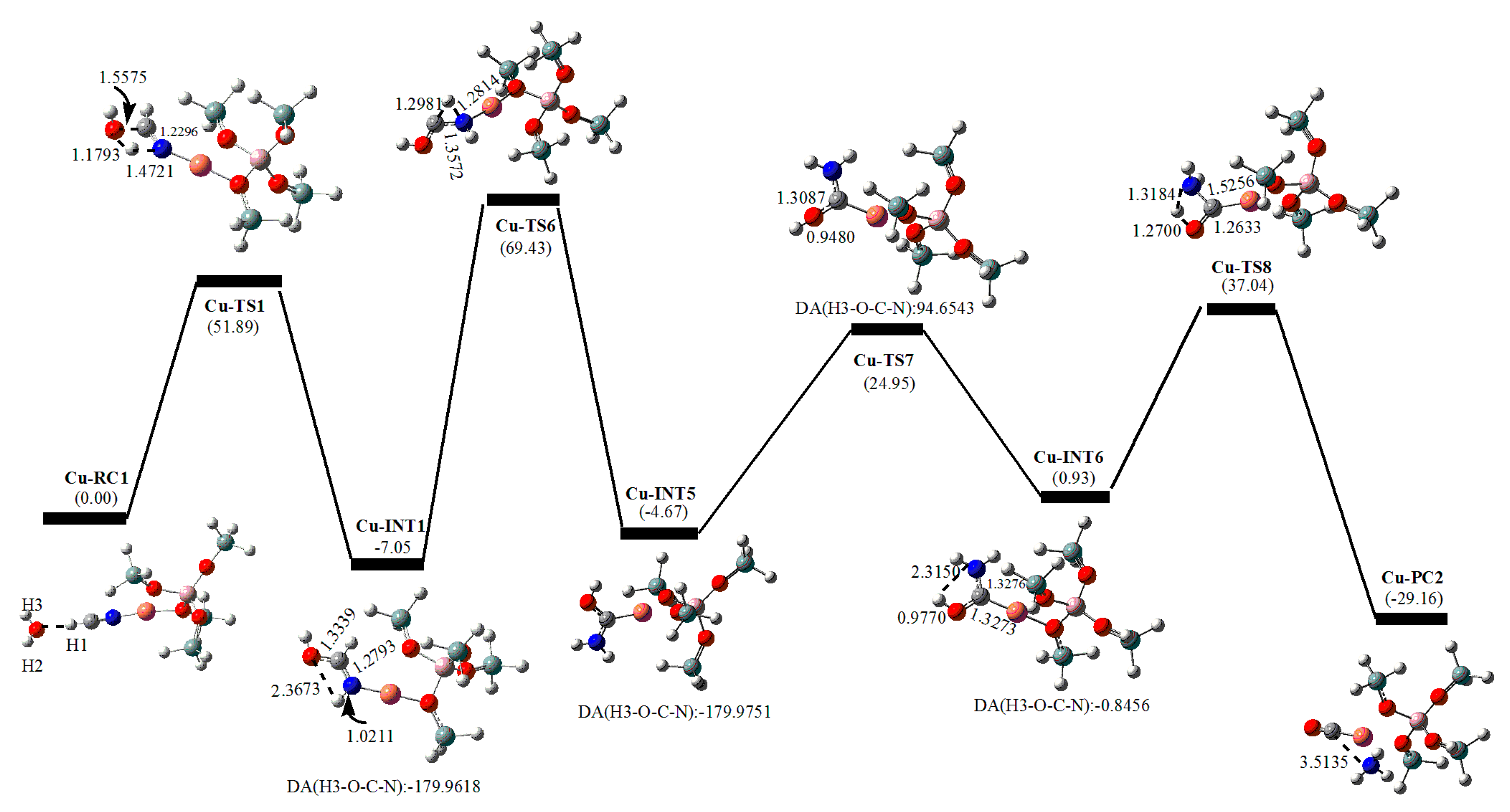
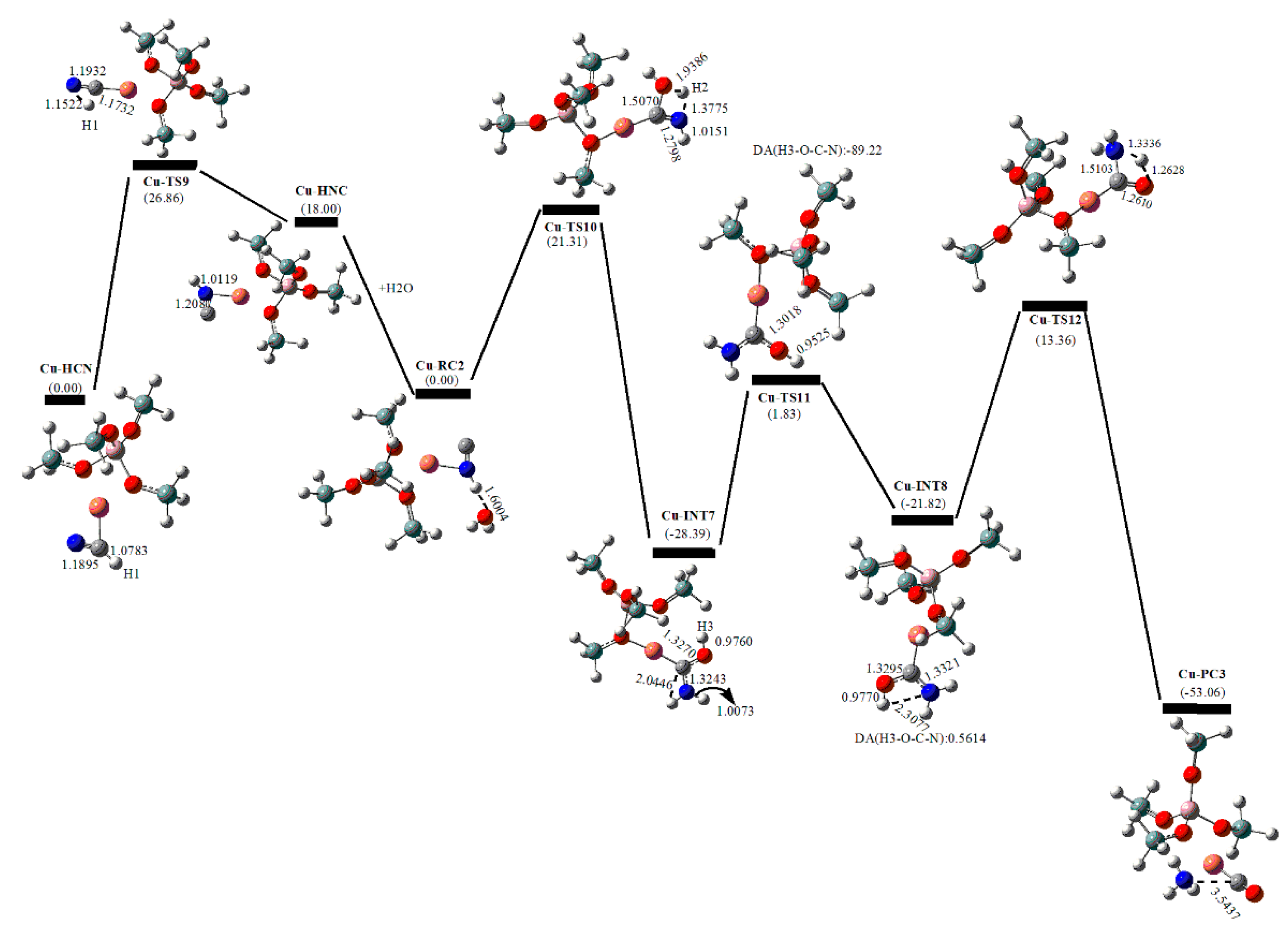
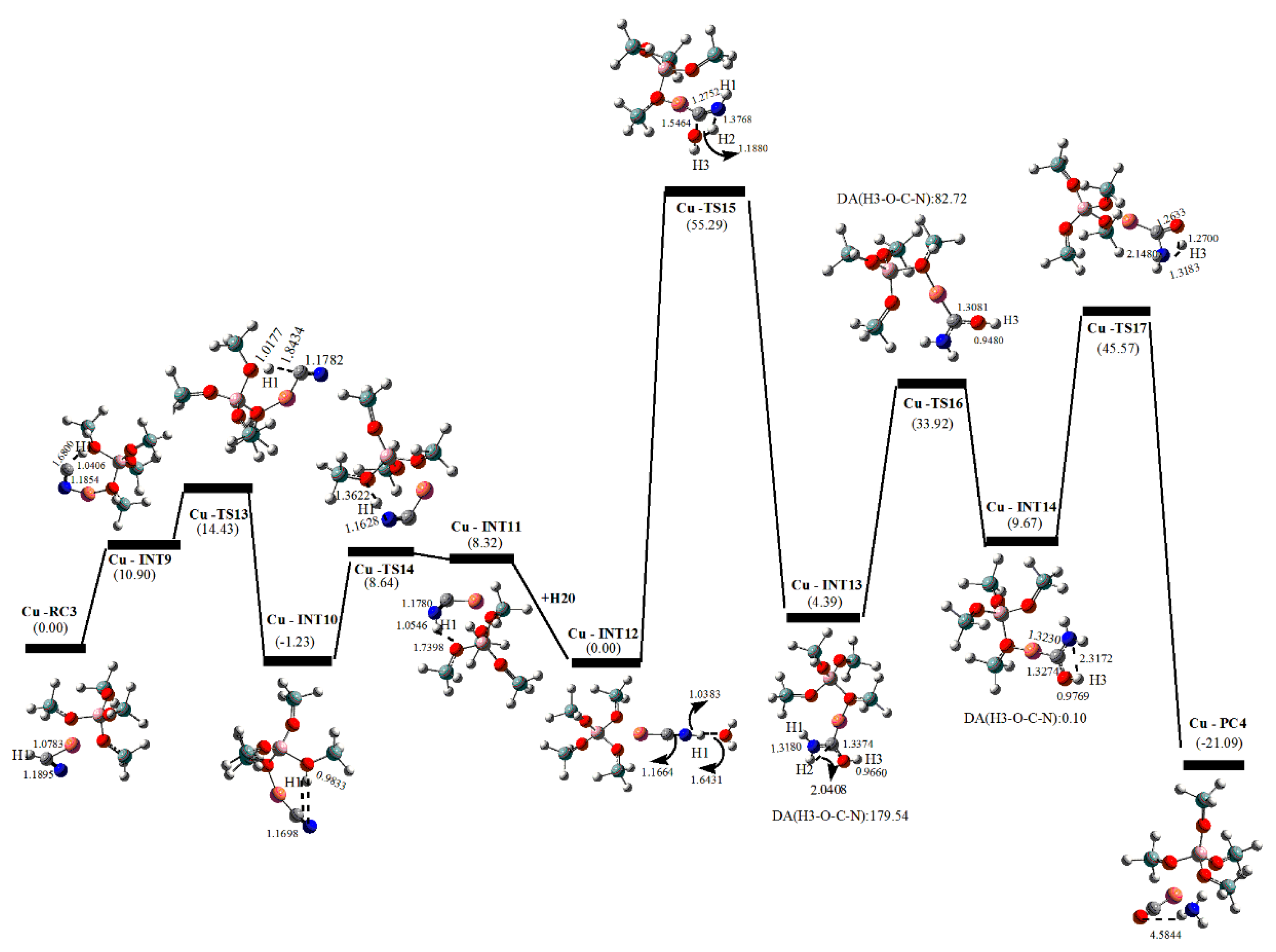
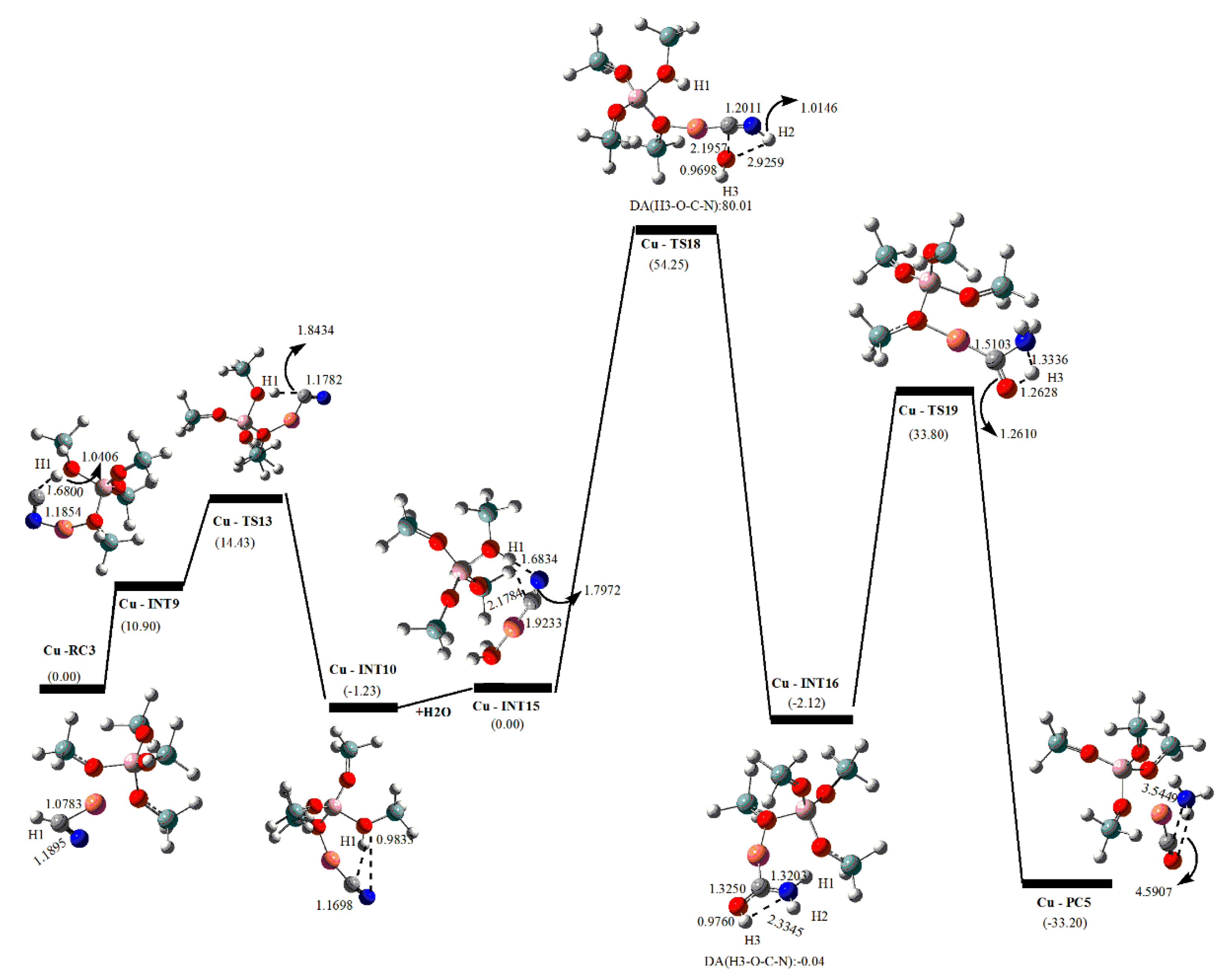
Publisher’s Note: MDPI stays neutral with regard to jurisdictional claims in published maps and institutional affiliations. |
© 2022 by the authors. Licensee MDPI, Basel, Switzerland. This article is an open access article distributed under the terms and conditions of the Creative Commons Attribution (CC BY) license (https://creativecommons.org/licenses/by/4.0/).
Share and Cite
Zhang, Y.; Li, F.; Yang, C.; Peng, G.; Wang, G.; Xia, F. Theoretical Analysis of the Catalytic Hydrolysis Mechanism of HCN over Cu-ZSM-5. Catalysts 2022, 12, 648. https://doi.org/10.3390/catal12060648
Zhang Y, Li F, Yang C, Peng G, Wang G, Xia F. Theoretical Analysis of the Catalytic Hydrolysis Mechanism of HCN over Cu-ZSM-5. Catalysts. 2022; 12(6):648. https://doi.org/10.3390/catal12060648
Chicago/Turabian StyleZhang, Yankun, Fenji Li, Cuicui Yang, Guojian Peng, Guowei Wang, and Futing Xia. 2022. "Theoretical Analysis of the Catalytic Hydrolysis Mechanism of HCN over Cu-ZSM-5" Catalysts 12, no. 6: 648. https://doi.org/10.3390/catal12060648
APA StyleZhang, Y., Li, F., Yang, C., Peng, G., Wang, G., & Xia, F. (2022). Theoretical Analysis of the Catalytic Hydrolysis Mechanism of HCN over Cu-ZSM-5. Catalysts, 12(6), 648. https://doi.org/10.3390/catal12060648





